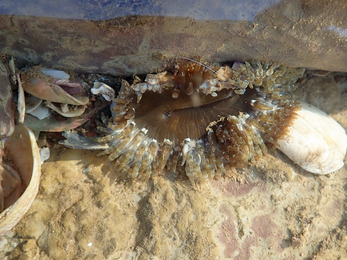The Isle of Wight is known for its beautiful beaches, but for Claire Saxby and her great-nephew, 13 year-old 'Ace Crab Catcher' Harry, these shores are full of hidden treasures. With Harry living on the Island and Claire being a regular visitor, this dynamic duo are always keen to comb the Island's coastline for wildlife.
Venturing out on Sunday 21st April - a beautifully warm, still evening - they decided to head to Hanover Point just by Compton Bay. They had done surveys at this site before, in August and December 2018, and were hoping to see what had changed. Overall the pair managed to identify a whopping 39 species in only 2.5 hours - an amazing achievement!
Anemones were numerous, including dahlia anemones (Urticina felina) in several different colour variations. A beadlet anemone (Actinia equina) showed off the bright blue stinging cells at the base of its tentacles, which it uses to fight rivals. You can also see a snakelocks anemone (Anemonia viridis) - one of the few that doesn't retract its tentacles, meaning it can make the most of the sunlight.



















